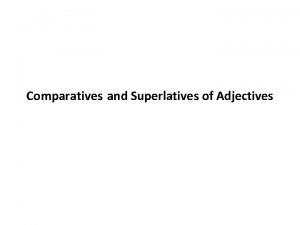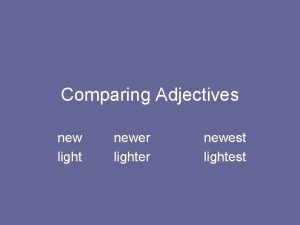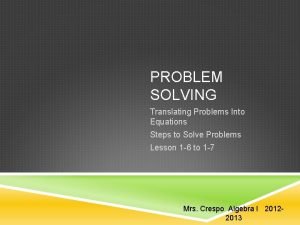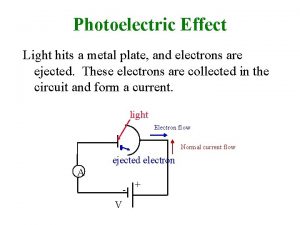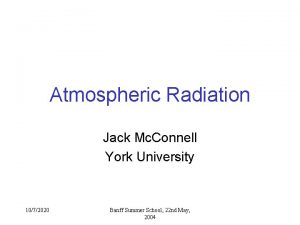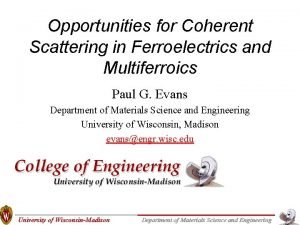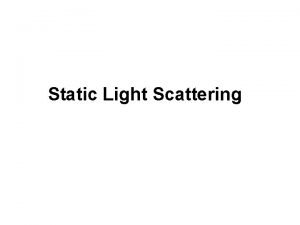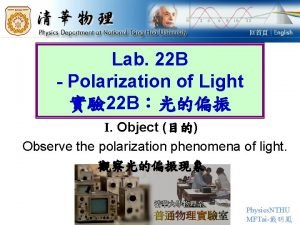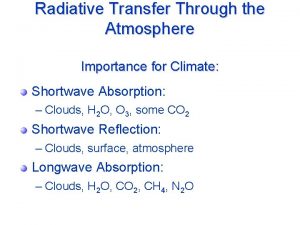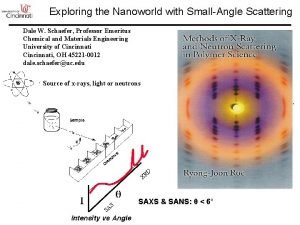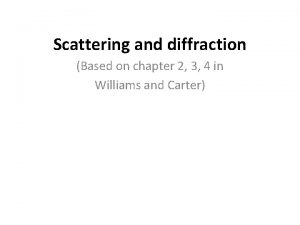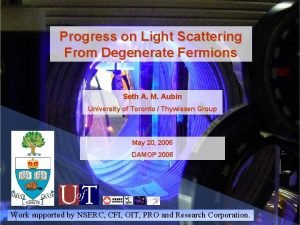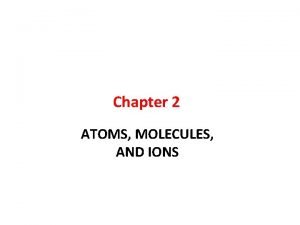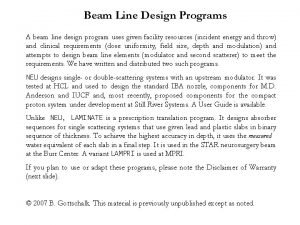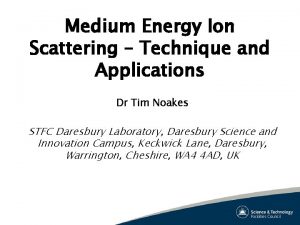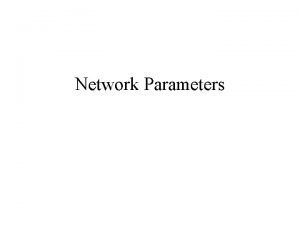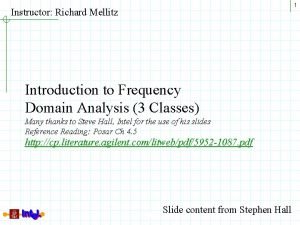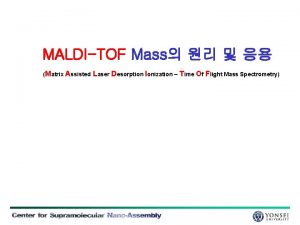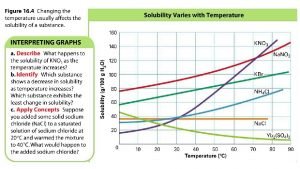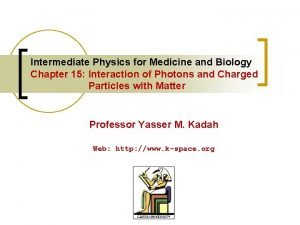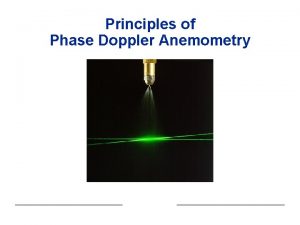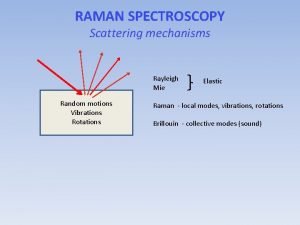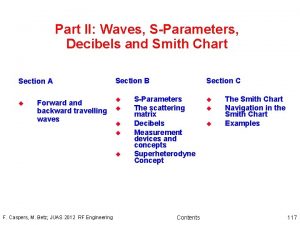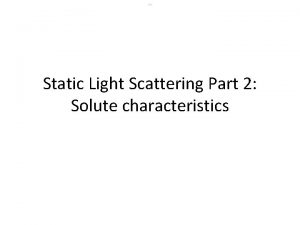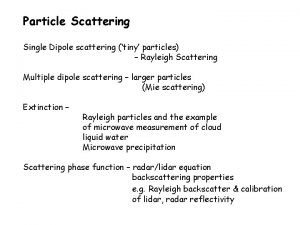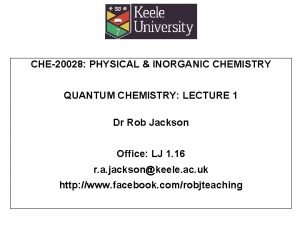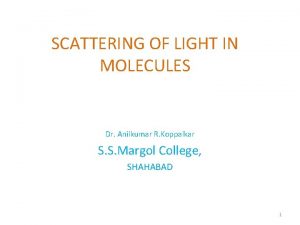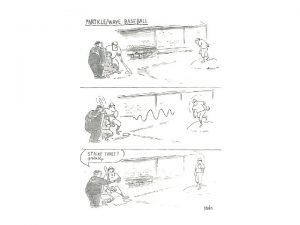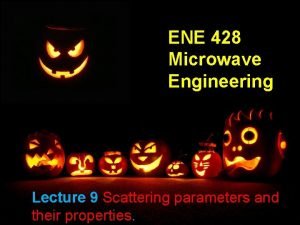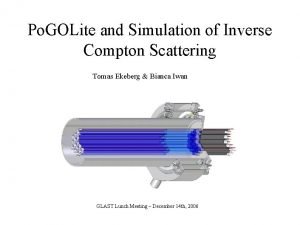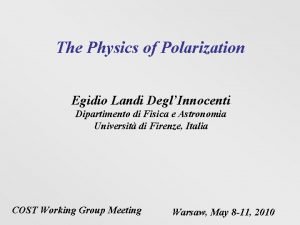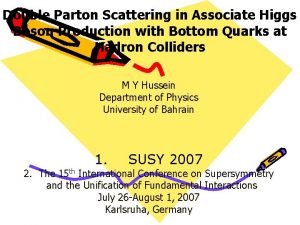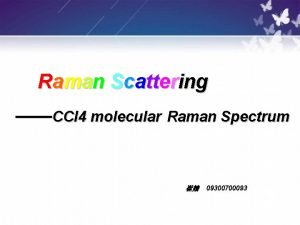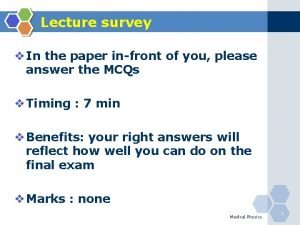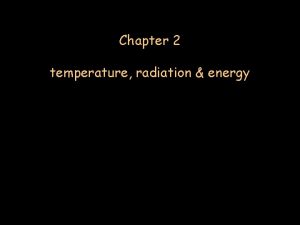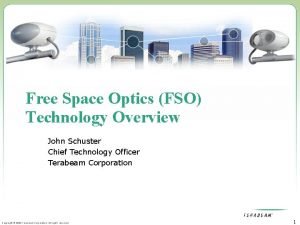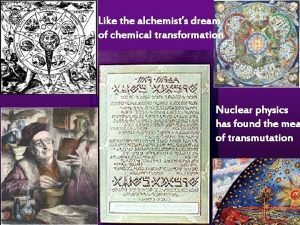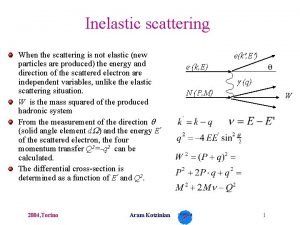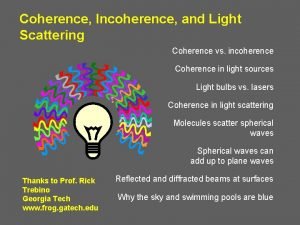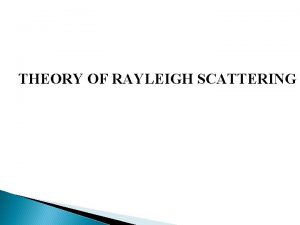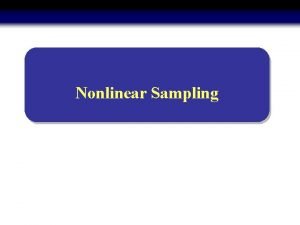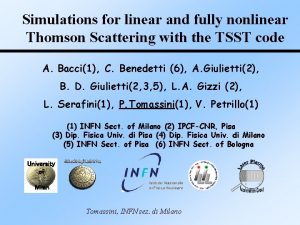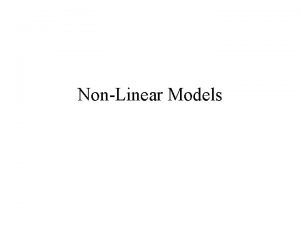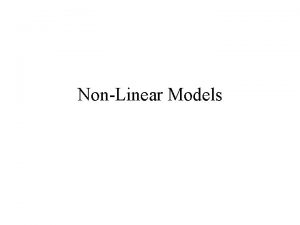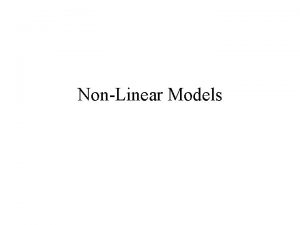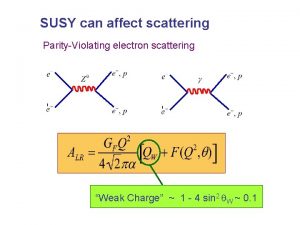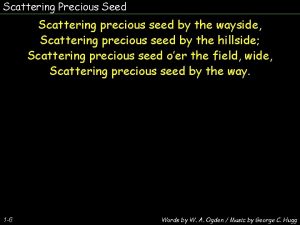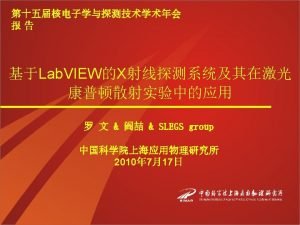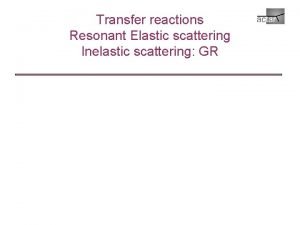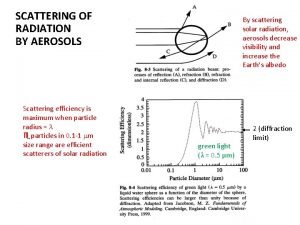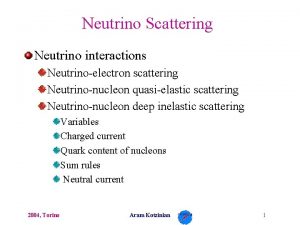Nonlinear Thomson Scattering Many of the newer Thomson













![Bend Undulater Wiggler e– e– white source Flux [ph/s/0. 1%bw] Brightness [ph/s/mm 2/mr 2/0. Bend Undulater Wiggler e– e– white source Flux [ph/s/0. 1%bw] Brightness [ph/s/mm 2/mr 2/0.](https://slidetodoc.com/presentation_image_h2/6c4b3305b1b9534c372f47aef28392c4/image-14.jpg)






































- Slides: 52

Nonlinear Thomson Scattering. . . Many of the newer Thomson Sources are based on a PULSED Laser (e. g. all of the high-energy lasers are pulsed by their very nature) Have developed a general theory to cover radiation calculations in the general case of a pulsed, high field strength laser interacting with electrons in a Thomson scattering arrangement. The new theory shows that in many situations the estimates people do to calculate flux and brilliance, based on a constant amplitude models, are just plain wrong. The new theory is general enough to cover all “ 1 -D” undulater calculations and all pulsed laser Thomson scattering calculations. The main “new physics” that the new calculations include properly is the fact that the electron motion changes based on the local value of the field strength squared. Such ponderomotive forces (i. e. , forces proportional to the field strength squared), lead to a detuning of the emission, angle dependent Doppler shifts of the emitted scattered radiation, and additional transverse dipole emission that this theory can calculate. ODU Colloquium Thomas Jefferson National Accelerator Facility Operated by the Southeastern Universities Research Association for the U. S. Department of Energy 15 February 2005

Ancient History. . . Early 1960 s: Laser Invented Brown and Kibble (1964): Earliest definition of the field strength parameters K and/or a in the literature that I’m aware of Interpreted frequency shifts that occur at high fields as a “relativistic mass shift”. Sarachik and Schappert (1970): Power into harmonics at high K and/or a. Full calculation for CW (monochromatic) laser. Later referenced, corrected, and extended by workers in fusion plasma diagnostics. Alferov, Bashmakov, and Bessonov (1974): Undulater/Insertion Device theories developed under the assumption of constant field strength. Numerical codes developed to calculate “real” fields in undulaters. Coisson (1979): Simplified undulater theory, which works at low K and/or a, developed to understand the frequency distribution of “edge” emission, or emission from “short” magnets, i. e. , including pulse effects ODU Colloquium Thomas Jefferson National Accelerator Facility Operated by the Southeastern Universities Research Association for the U. S. Department of Energy 15 February 2005

Coisson’s Spectrum from a Short Magnet Coisson low-field strength undulater spectrum* *R. Coisson, Phys. Rev. A 20, 524 (1979) ODU Colloquium Thomas Jefferson National Accelerator Facility Operated by the Southeastern Universities Research Association for the U. S. Department of Energy 15 February 2005

Dipole Radiation Assume a single charge moves in the x direction Introduce scalar and vector potential for fields. Retarded solution to wave equation (Lorenz gauge), ODU Colloquium Thomas Jefferson National Accelerator Facility Operated by the Southeastern Universities Research Association for the U. S. Department of Energy 15 February 2005

Dipole Radiation Polarized in the plane containing and ODU Colloquium Thomas Jefferson National Accelerator Facility Operated by the Southeastern Universities Research Association for the U. S. Department of Energy 15 February 2005

Dipole Radiation Define the Fourier Transform With these conventions Parseval’s Theorem is Blue Sky! This equation does not follow the typical (see Jackson) convention that combines both positive and negative frequencies together in a single positive frequency integral. The reason is that we would like to apply Parseval’s Theorem easily. By symmetry, the difference is a factor of two. ODU Colloquium Thomas Jefferson National Accelerator Facility Operated by the Southeastern Universities Research Association for the U. S. Department of Energy 15 February 2005

Dipole Radiation For a motion in three dimensions Vector inside absolute value along the magnetic field Vector inside absolute value along the electric field. To get energy into specific polarization, take scaler product with the polarization vector ODU Colloquium Thomas Jefferson National Accelerator Facility Operated by the Southeastern Universities Research Association for the U. S. Department of Energy 15 February 2005

Co-moving Coordinates. . . Assume radiating charge is moving with a velocity close to light in a direction taken to be the z axis, and the charge is on average at rest in this coordinate system For the remainder of the presentation, quantities referred to the moving coordinates will have primes; unprimed quantities refer to the lab system In the co-moving system the dipole radiation pattern applies ODU Colloquium Thomas Jefferson National Accelerator Facility Operated by the Southeastern Universities Research Association for the U. S. Department of Energy 15 February 2005

New Coordinates Resolve the polarization of scattered energy into that perpendicular (σ) and that parallel (π) to the scattering plane ODU Colloquium Thomas Jefferson National Accelerator Facility Operated by the Southeastern Universities Research Association for the U. S. Department of Energy 15 February 2005

Polarization It follows that So the energy into the two polarizations in the beam frame is ODU Colloquium Thomas Jefferson National Accelerator Facility Operated by the Southeastern Universities Research Association for the U. S. Department of Energy 15 February 2005

Comments/Sum Rule. . . There is no radiation parallel or anti-parallel to the x-axis for x-dipole motion In the forward direction , the radiation polarization is parallel to the xaxis for an x-dipole motion One may integrate over all angles to obtain a result for the total energy radiated Generalized Larmor ODU Colloquium Thomas Jefferson National Accelerator Facility Operated by the Southeastern Universities Research Association for the U. S. Department of Energy 15 February 2005

Sum Rule Total energy sum rule Parseval’s Theorem again gives “standard” Larmor formula ODU Colloquium Thomas Jefferson National Accelerator Facility Operated by the Southeastern Universities Research Association for the U. S. Department of Energy 15 February 2005

Energy Distribution in Lab Frame By placing the expression for the Doppler shifted frequency and angles inside the transformed beam frame distribution. Total energy radiated from d'z is the same as d'x and d'y for same dipole strength. ODU Colloquium Thomas Jefferson National Accelerator Facility Operated by the Southeastern Universities Research Association for the U. S. Department of Energy 15 February 2005
![Bend Undulater Wiggler e e white source Flux phs0 1bw Brightness phsmm 2mr 20 Bend Undulater Wiggler e– e– white source Flux [ph/s/0. 1%bw] Brightness [ph/s/mm 2/mr 2/0.](https://slidetodoc.com/presentation_image_h2/6c4b3305b1b9534c372f47aef28392c4/image-14.jpg)
Bend Undulater Wiggler e– e– white source Flux [ph/s/0. 1%bw] Brightness [ph/s/mm 2/mr 2/0. 1%bw] e– partially coherent source powerful white source ODU Colloquium Thomas Jefferson National Accelerator Facility Operated by the Southeastern Universities Research Association for the U. S. Department of Energy 15 February 2005

Weak Field Undulater Spectrum Generalizes Coisson to arbitrary observation angles ODU Colloquium Thomas Jefferson National Accelerator Facility Operated by the Southeastern Universities Research Association for the U. S. Department of Energy 15 February 2005

Strong Field Case ODU Colloquium Thomas Jefferson National Accelerator Facility Operated by the Southeastern Universities Research Association for the U. S. Department of Energy 15 February 2005

High K ODU Colloquium Thomas Jefferson National Accelerator Facility Operated by the Southeastern Universities Research Association for the U. S. Department of Energy 15 February 2005

High K Inside the insertion device the average (z) velocity is with corresponding To apply dipole distributions, must be in this frame to begin with ODU Colloquium Thomas Jefferson National Accelerator Facility Operated by the Southeastern Universities Research Association for the U. S. Department of Energy 15 February 2005

=100, distances are normalized by λ 0 / 2π ODU Colloquium Thomas Jefferson National Accelerator Facility Operated by the Southeastern Universities Research Association for the U. S. Department of Energy 15 February 2005

Therefore. . . Coisson’s Theory may be generalized to arbitrary observation angles by using the proper polarization decomposition All kinematic parameters, including the angular distribution functions and frequency distributions, are just the same as in the weak field case, except unstarred quantities should be replaced by starred quantities In particular, the (FEL) resonance condition becomes ODU Colloquium Thomas Jefferson National Accelerator Facility Operated by the Southeastern Universities Research Association for the U. S. Department of Energy 15 February 2005

Thomson Scattering. . . Purely “classical” scattering of photons by electrons Thomson regime defined by the photon energy in the electron rest frame being small compared to the rest energy of the electron, allowing one to neglect the quantum mechanical “Dirac” recoil on the electron In this case electron radiates at the same frequency as incident photon for low enough field strengths Classical dipole radiation pattern is generated in beam frame Therefore radiation patterns, at low field strength, can be largely copied from textbooks Note on terminology: Some authors call any scattering of photons by free electrons Compton Scattering. Compton observed (the so-called Compton effect) frequency shifts in X-ray scattering off (resting!) electrons that depended on scattering angle. Such frequency shifts arise only when the energy of the photon in the rest frame becomes comparable with 0. 511 Me. V. ODU Colloquium Thomas Jefferson National Accelerator Facility Operated by the Southeastern Universities Research Association for the U. S. Department of Energy 15 February 2005

Simple Kinematics e- Beam Frame Lab Frame ODU Colloquium Thomas Jefferson National Accelerator Facility Operated by the Southeastern Universities Research Association for the U. S. Department of Energy 15 February 2005

In beam frame scattered photon radiated with wave vector Back in the lab frame, the scattered photon energy Es is ODU Colloquium Thomas Jefferson National Accelerator Facility Operated by the Southeastern Universities Research Association for the U. S. Department of Energy 15 February 2005

Electron in a Plane Wave Assume linearly-polarized pulsed laser beam moving in the direction (electron charge is –e) Polarization 4 -vector Light-like incident propagation 4 -vector ODU Colloquium Thomas Jefferson National Accelerator Facility Operated by the Southeastern Universities Research Association for the U. S. Department of Energy 15 February 2005

Electromagnetic Field Our goal is to find xμ(τ)=(ct(τ), x(τ), y(τ), z(τ)) when the 4 -velocity uμ(τ)=(cdt/dτ, dx/dτ, dy/dτ, dz/dτ)(τ) satisfies duμ/dτ= –e. Fμνuν/mc where τ is proper time. For any solution to the equations of motion. Proportional to amount frequencies up-shifted going to beam frame ODU Colloquium Thomas Jefferson National Accelerator Facility Operated by the Southeastern Universities Research Association for the U. S. Department of Energy 15 February 2005

ξ is exactly proportional to the proper time! On the orbit Integrate with respect to ξ instead of τ. Now where the unitless vector potential is f(ξ)=-e. A(ξ )/mc 2. ODU Colloquium Thomas Jefferson National Accelerator Facility Operated by the Southeastern Universities Research Association for the U. S. Department of Energy 15 February 2005

Electron Orbit Direct Force from Electric Field Ponderomotive Force ODU Colloquium Thomas Jefferson National Accelerator Facility Operated by the Southeastern Universities Research Association for the U. S. Department of Energy 15 February 2005

Energy Distribution ODU Colloquium Thomas Jefferson National Accelerator Facility Operated by the Southeastern Universities Research Association for the U. S. Department of Energy 15 February 2005

Effective Dipole Motions: Lab Frame And the (Lorentz invariant!) phase is ODU Colloquium Thomas Jefferson National Accelerator Facility Operated by the Southeastern Universities Research Association for the U. S. Department of Energy 15 February 2005

Summary. . Overall structure of the distributions is very like that from the general dipole motion, only the effective dipole motion, incuding physical effects such as the relativistic motion of the electrons and retardation, must be generalized beyond the straight Fourier transform of the field At low field strengths (f <<1), the distributions reduce directly to the classical Fourier transform dipole distributions The effective dipole motion from the ponderomotive force involves a simple projection of the incident wave vector in the beam frame onto the axis of interest, multiplied by the general ponderomotive dipole motion integral The radiation from the two transverse dipole motions are compressed by the same angular factors going from beam to lab frame as appears in the simple dipole case. The longitudinal dipole radiation is also transformed between beam and lab frame by the same fraction as in the simple longitudinal dipole motion. Thus the usual compression into a 1/γ cone applies ODU Colloquium Thomas Jefferson National Accelerator Facility Operated by the Southeastern Universities Research Association for the U. S. Department of Energy 15 February 2005

Weak Field Thomson Backscatter With Φ = π and f <<1 the result is identical to the weak field undulater result with the replacement of the magnetic field Fourier transform by the electric field Fourier transform Undulator Thomson Backscatter Driving Field Forward Frequency Lorentz contract + Doppler Double Doppler ODU Colloquium Thomas Jefferson National Accelerator Facility Operated by the Southeastern Universities Research Association for the U. S. Department of Energy 15 February 2005

High Field Strength Thomson Backscatter For a flat incident laser pulse the main results are very similar to those from undulaters with the following correspondences Undulater Thomson Backscatter Field Strength Forward Frequency Transverse Pattern NB, be careful with the radiation pattern, it is the same at small angles, but quite a bit different at large angles ODU Colloquium Thomas Jefferson National Accelerator Facility Operated by the Southeastern Universities Research Association for the U. S. Department of Energy 15 February 2005

Realistic Pulse Distribution at High a In general, it’s easiest to just numerically integrate the lab-frame expression for the spectrum in terms of Dx , Dy, and Dz. A 105 to 106 point Simpson integration is adequate for most purposes. We’ve done two types of pulses, flat pulses to reproduce the previous results and to evaluate numerical error, and Gaussian Laser pulses. One may utilize a two-timing approximation (i. e. , the laser pulse is a slowly varying sinusoid with amplitude a(ξ)), and the fundamental expressions, to write the energy distribution at any angle in terms of Bessel function expansions and a ξ integral over the modulation amplitude. This approach actually has a limited domain of applicability (K, a<0. 1) ODU Colloquium Thomas Jefferson National Accelerator Facility Operated by the Southeastern Universities Research Association for the U. S. Department of Energy 15 February 2005

Forward Direction: Flat Pulse 20 -period equivalent undulater: ODU Colloquium Thomas Jefferson National Accelerator Facility Operated by the Southeastern Universities Research Association for the U. S. Department of Energy 15 February 2005

ODU Colloquium Thomas Jefferson National Accelerator Facility Operated by the Southeastern Universities Research Association for the U. S. Department of Energy 15 February 2005

Forward Direction: Gaussian Pulse Apeak and λ 0 chosen for same intensity and same rms pulse length as previous slide ODU Colloquium Thomas Jefferson National Accelerator Facility Operated by the Southeastern Universities Research Association for the U. S. Department of Energy 15 February 2005

Radiation Distributions: Backscatter Gaussian Pulse σ at first harmonic peak Courtesy: Adnan Doyuran (UCLA) ODU Colloquium Thomas Jefferson National Accelerator Facility Operated by the Southeastern Universities Research Association for the U. S. Department of Energy 15 February 2005

Radiation Distributions: Backscatter Gaussian π at first harmonic peak Courtesy: Adnan Doyuran (UCLA) ODU Colloquium Thomas Jefferson National Accelerator Facility Operated by the Southeastern Universities Research Association for the U. S. Department of Energy 15 February 2005

Radiation Distributions: Backscatter Gaussian σ at second harmonic peak Courtesy: Adnan Doyuran (UCLA) ODU Colloquium Thomas Jefferson National Accelerator Facility Operated by the Southeastern Universities Research Association for the U. S. Department of Energy 15 February 2005

90 Degree Scattering ODU Colloquium Thomas Jefferson National Accelerator Facility Operated by the Southeastern Universities Research Association for the U. S. Department of Energy 15 February 2005

90 Degree Scattering And the phase is ODU Colloquium Thomas Jefferson National Accelerator Facility Operated by the Southeastern Universities Research Association for the U. S. Department of Energy 15 February 2005

Radiation Distribution: 90 Degree Gaussian Pulse σ at first harmonic peak Courtesy: Adnan Doyuran (UCLA) ODU Colloquium Thomas Jefferson National Accelerator Facility Operated by the Southeastern Universities Research Association for the U. S. Department of Energy 15 February 2005

Radiation Distributions: 90 Degree Gaussian Pulse π at first harmonic peak Courtesy: Adnan Doyuran (UCLA) ODU Colloquium Thomas Jefferson National Accelerator Facility Operated by the Southeastern Universities Research Association for the U. S. Department of Energy 15 February 2005

Polarization Sum: Gaussian 90 Degree Courtesy: Adnan Doyuran (UCLA) ODU Colloquium Thomas Jefferson National Accelerator Facility Operated by the Southeastern Universities Research Association for the U. S. Department of Energy 15 February 2005

Radiation Distributions: 90 Degree Gaussian Pulse second harmonic peak Second harmonic emission on axis from ponderomotive dipole! Courtesy: Adnan Doyuran (UCLA) ODU Colloquium Thomas Jefferson National Accelerator Facility Operated by the Southeastern Universities Research Association for the U. S. Department of Energy 15 February 2005

Total Energy Radiated Lienard’s Generalization of Larmor Formula (1898!) Barut’s Version Usual Larmor term From ponderomotive dipole ODU Colloquium Thomas Jefferson National Accelerator Facility Operated by the Southeastern Universities Research Association for the U. S. Department of Energy 15 February 2005

Some Cases Total radiation from electron initially at rest For a flat pulse exactly (Sarachik and Schappert) ODU Colloquium Thomas Jefferson National Accelerator Facility Operated by the Southeastern Universities Research Association for the U. S. Department of Energy 15 February 2005

For Circular Polarization Only specific case I can find in literature completely calculated has sin Φ = 0 and flat pulses (d. A/dξ = 0). The orbits are then pure circles ODU Colloquium Thomas Jefferson National Accelerator Facility Operated by the Southeastern Universities Research Association for the U. S. Department of Energy 15 February 2005

For zero average velocity in middle of pulse Sokolov and Ternov, in Radiation from Relativistic Electrons, give and the general formula (which goes back to Schott and the turn of the 20 th century!) checks out ODU Colloquium Thomas Jefferson National Accelerator Facility Operated by the Southeastern Universities Research Association for the U. S. Department of Energy 15 February 2005

Conclusions. . . Recent development of superconducting cavities has enabled CW operation at energy gains in excess of 20 MV/m, and acceleration of average beam currents of 10 s of m. A. The ideas of Beam Recirculation and Energy Recovery have been introduced; how these concepts may be combined to yield a new class of accelerators that can be used in many interesting applications has been discussed. I’ve given you some indication about the historical development of recirculating SRF linacs. The present knowledge on beam recirculation and its limitations in a superconducting environment, leads us to think that recirculating accelerators of several Ge. V energy, and with beam currents approaching those in storage ring light sources, are possible. ODU Colloquium Thomas Jefferson National Accelerator Facility Operated by the Southeastern Universities Research Association for the U. S. Department of Energy 15 February 2005

Conclusions. . I’ve shown how dipole solutions to the Maxwell equations can be used to obtain and understand very general expressions for the spectral angular energy distributions for weak field undulaters and general weak field Thomson Scattering photon sources A “new” calculation scheme for high intensity pulsed laser Thomson Scattering has been developed. This same scheme can be applied to calculate spectral properties of “short”, high-K wigglers. Due to ponderomotive broadening, it is simply wrong to use single-frequency estimates of flux and brilliance in situations where the square of the field strength parameter becomes comparable to or exceeds the (1/N) spectral width of the induced electron wiggle The new theory is especially useful when considering Thomson scattering of Table Top Tera. Watt lasers, which have exceedingly high field and short pulses. Any calculation that does not include ponderomotive broadening is incorrect. ODU Colloquium Thomas Jefferson National Accelerator Facility Operated by the Southeastern Universities Research Association for the U. S. Department of Energy 15 February 2005

Conclusions. . Because the laser beam in a Thomson scatter source can interact with the electron beam non-colinearly with the beam motion (a piece of physics that cannot happen in an undulater), ponderomotively driven transverse dipole motion is now possible This motion can generate radiation at the second harmonic of the up-shifted incident frequency on axis. The dipole direction is in the direction of laser incidence. Because of Doppler shifts generated by the ponderomotive displacement velocity induced in the electron by the intense laser, the frequency of the emitted radiation has an angular asymmetry. Sum rules for the total energy radiated, which generalize the usual Larmor/Lenard sum rule, have been obtained. ODU Colloquium Thomas Jefferson National Accelerator Facility Operated by the Southeastern Universities Research Association for the U. S. Department of Energy 15 February 2005
 New in comparative
New in comparative Comparative light
Comparative light Translating word problems into equations
Translating word problems into equations Newer drug delivery system
Newer drug delivery system Compton scattering
Compton scattering Scattering cross section in nuclear physics
Scattering cross section in nuclear physics Scattering efficiency
Scattering efficiency Coherent scattering
Coherent scattering Zimm plot excel
Zimm plot excel Polarisation by scattering
Polarisation by scattering Boltzmann law
Boltzmann law Small angle scattering
Small angle scattering Diffraction and scattering
Diffraction and scattering Rayleigh vs mie
Rayleigh vs mie Pauli blocking of light scattering in degenerate fermions
Pauli blocking of light scattering in degenerate fermions Rutherford scattering
Rutherford scattering Double scattering
Double scattering Elastic energy
Elastic energy Abcd short
Abcd short Scattering matrix
Scattering matrix Dynamic light scattering 원리
Dynamic light scattering 원리 Scattering of light in suspension
Scattering of light in suspension Conservation of momentum
Conservation of momentum Light scattering
Light scattering Rayleigh vs raman scattering
Rayleigh vs raman scattering Scattering matrix
Scattering matrix Rayleigh theory of light scattering
Rayleigh theory of light scattering Contoh refraksi gelombang
Contoh refraksi gelombang Rayleigh scattering intensity formula
Rayleigh scattering intensity formula Compton scattering
Compton scattering Dynamic scattering type lcd
Dynamic scattering type lcd Scattering of light
Scattering of light Rayleigh theory of light scattering
Rayleigh theory of light scattering Scattering in central force field
Scattering in central force field Properties of scattering matrix in microwave engineering
Properties of scattering matrix in microwave engineering Golite trig 2
Golite trig 2 Scattering matrix
Scattering matrix Advances in mri
Advances in mri Double parton scattering
Double parton scattering Raman scattering definition
Raman scattering definition Equivalent dose formula
Equivalent dose formula Light scattering
Light scattering Free space optics
Free space optics Angolo di scattering
Angolo di scattering Scattering reaction
Scattering reaction Elastic scattering vs inelastic
Elastic scattering vs inelastic Rayleigh scattering phase function
Rayleigh scattering phase function Coherence and incoherence
Coherence and incoherence Tư thế ngồi viết
Tư thế ngồi viết Ví dụ về giọng cùng tên
Ví dụ về giọng cùng tên Thể thơ truyền thống
Thể thơ truyền thống Hát lên người ơi
Hát lên người ơi Khi nào hổ mẹ dạy hổ con săn mồi
Khi nào hổ mẹ dạy hổ con săn mồi
